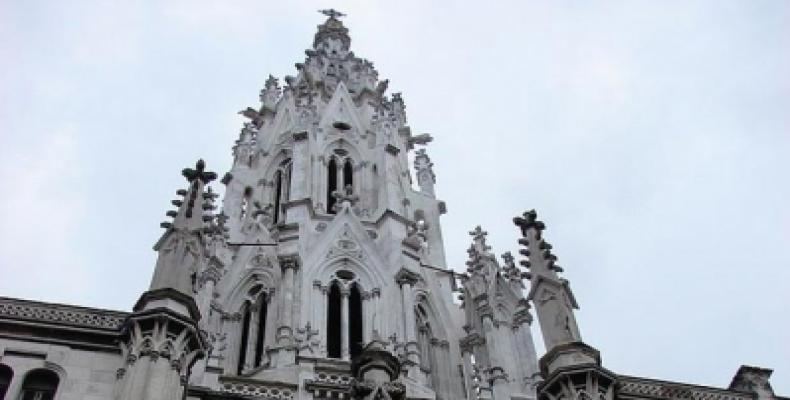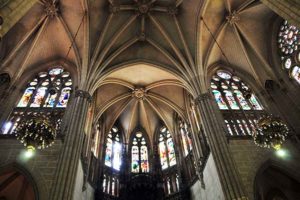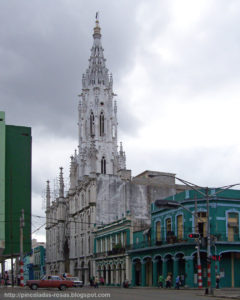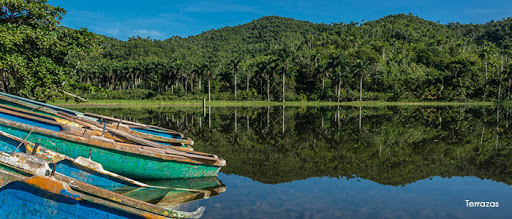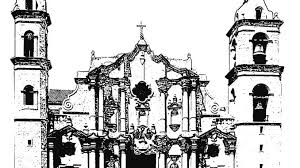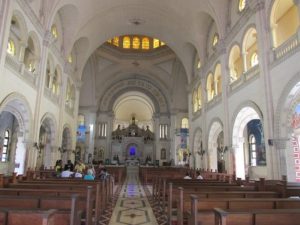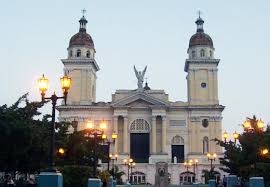UN RECORRIDO HISTORICO DE LAS IGLESIAS HABANERAS.
Se dice que la primera iglesia que existió en La Habana era un bohío que algunos sitúan en el espacio que ocupó luego el Palacio del Segundo Cabo. En 1550, destruido ese bohío, se inició la construcción de una iglesia de cal y canto.
En julio de 1555 el corsario francés Jacques de Sores se apoderó de La Habana. Prendió fuego a la primitiva villa y el incendio destruyó la iglesia: solo quedaron en pie las paredes. Hacia 1560 La Habana estaba aún sin iglesia, que quedaría terminada en 1574. Se hallaba esta iglesia en el lugar que posteriormente ocupó el Palacio de los Capitanes Generales. Estaba dedicada la iglesia a San Cristóbal, patrón de la ciudad, y desde que se establecieron las parroquias del Espíritu Santo, Cristo del Buen Viaje y Santo Ángel, tomó el nombre de Parroquial Mayor.
El 30 de junio de 1741 un rayo cayó sobre el navío Invencible, anclado en el puerto de La Habana. La explosión hizo que se resquebrajaran muchos edificios de la ciudad, y la Parroquial Mayor quedó en estado de ruina. En 1772 provisionalmente se estableció el culto en el oratorio de San Felipe de Neri, convertido transitoriamente en Parroquial hasta que el 9 de diciembre de 1777 se realizó el traslado de la Parroquial Mayor desde el oratorio hasta la mencionada iglesia de los jesuitas, transformada más tarde en Santa Iglesia Catedral, en el mismo sitio que ocupa en la plaza que lleva su nombre.
IGLESIAS HABANERAS. SU HISTORIA.
La iglesia Jesús de Miramar, en la Quinta Avenida habanera, es, con relación al área que ocupa, el mayor templo de Cuba, pero la Catedral de Santiago la supera en cuanto a capacidad para los fieles.
Sin embargo, la más alta construcción religiosa cubana es la parroquia del Sagrado Corazón, la comúnmente llamada iglesia de Reina. Solo su torre tiene una altura de cincuenta metros y es de setenta y cuatro metros el alto total del templo. Se trata, aseguran especialistas, de una edificación “importante en la silueta de La Habana”.
El pórtico de la parroquia es impresionante. Lo preside una gran imagen del Corazón de Jesús, tallada en madera, que tiene a cada uno de sus lados las imágenes, también de bulto, de los santos jesuitas San Ignacio de Loyola y Francisco Javier. Famosos son los ciento sesenta y nueve vitrales del templo. De ellos, treinta y tres grandes y ciento treinta y seis pequeños. Todos confeccionados de manera exclusiva para la iglesia habanera por la Casa Mauméjean, de Madrid-París-San Sebastián. El altar es una verdadera filigrana artística. Compuesto de alabastro, madera y bronce, traído en piezas y montado en su lugar bajo la dirección de su autor, el sacerdote asturiano Félix Granda, buen artesano y artista plástico aficionado.
Importante también en la silueta de La Habana, aunque de menor relieve, es la imagen de bulto de la virgen del Carmen colocada en lo alto de la torre 63 metros” de la iglesia que lleva su nombre en la calzada de Infanta esquina a Neptuno. Una imagen en bronce esculpida en Italia, obra del artista napolitano Guido de Michel, que es una de las estatuas más grandes de La Habana; pesa catorce toneladas.
En 1923 los padres carmelitas descalzos obtuvieron el disfrute de la parroquia del Carmen y edificaron ese lujoso templo. Una iglesia muy amplia y ornamentada, de un estilo exageradamente barroco, tal como nunca se conoció en nuestro siglo XVIII y que muestra claras influencias del barroco mexicano.
Esa comunidad religiosa venía de la iglesia-convento de la calle Aguiar esquina a Obrapía. En este edificio, construido en 1693, radicó la iglesia y convento de la congregación de San Felipe de Neri hasta que en 1784 lo ocuparon los padres capuchinos. El viejo templo de San Felipe de Neri se convirtió entonces en la sede principal del Banco del Comercio, para lo cual se le hicieron en su interior modificaciones indispensables. Ya en la Revolución siguió siendo agencia bancaria hasta que se instaló allí la Empresa Cubana de Acuñaciones. Con el tiempo se transformaría en una sala de concierto, el Oratorio de San Felipe de Neri.
LOS CINCO TEMPLOS DE UNA CALLE
No es el templo de San Felipe de Neri la única iglesia que sufrió un cambio radical en sus objetivos. La de las Ursulinas, en la calle Egido, pasó a ser el cine Universal, y el viejo convento de las monjas de esa congregación, contiguo a la iglesia, lejos de ser demolido cuando las religiosas se trasladaron a una nueva y hermosa edificación en las Alturas de Miramar, pasó a albergar viviendas y establecimientos comerciales.
Nada quedó del convento de Santa Catalina de Sena ni de su iglesia, en la calle Compostela entre O Reilly y Aguacate, cuando en 1918 las monjas dominicas se trasladaron a un edificio mayor en la calle 25 entre Paseo y A, en el Vedado. En el espacio que ocupó se construyó el edificio de La Metropolitana, para oficinas y sede de compañías de seguro, entre ellas, la de ese nombre, y la sucursal, muy suntuosa, del Nacional City Bank de Nueva York, hoy una agencia del Banco Metropolitano.
El convento de Santa Teresa, con iglesia anexa en Compostela esquina a Teniente Rey, quedó convertido en almacén cuando las monjas que lo ocupaban pasaron, en 1929, al edificio de la calle 13 entre 20 y 22, también en el Vedado., aunque la iglesia, con el tiempo, volvió a abrirse al culto bajo la advocación de María Auxiliadora. El Beaterio de Teresas existía desde 1647. Solo en la calle que terminaría llevando su nombre, construyó Compostela cinco templos: los ya aludidos de Santa Catalina y Santa Teresa, ambos con convento, el de Belén, con su asilo de convalecientes, el de San Isidro, con el hospital de su nombre, y del Santo Ángel Custodio.
HISTORICAL JOURNEY OF HAVANA’S CHURCHES.
It is said that the first church that existed in Havana was a bohío that someplace in the space that later occupied the Palacio del Segundo Cabo. In 1550, that hut destroyed, the construction of a lime and song church began.
In July 1555 the French privateer Jacques de Sores seized Havana. He set fire to the primitive village and the fire destroyed the church: only the walls remained standing. By 1560 Havana was still without a church, which would be completed in 1574. This church was located in the place that later occupied the Palace of the Captains General. The church was dedicated to San Cristóbal, patron saint of the city, and since the parishes of the Holy Spirit, Cristo del Buen Viaje, and Santo Ángel were established, it took the name of Parroquial Mayor.
On June 30, 1741, lightning struck the Invincible ship, anchored in the port of Havana. The explosion caused many buildings in the city to collapse, and the Greater Parish Church was ruined. In 1772 the cult was provisionally established in the oratory of San Felipe de Neri, temporarily converted into a Parish Church until on December 9, 1777, the transfer of the Parish Church from the oratory to the mentioned Jesuit church was carried out, later transformed in Santa Iglesia Catedral, in the same place it occupies in the square that bears his name.
HABANERAS CHURCHES. ITS HISTORY.
The Jesús de Miramar church, on Havana’s Fifth Avenue, is, in relation to the area it occupies, the largest temple in Cuba, but the Cathedral of Santiago surpasses it in terms of capacity for the faithful.
However, the highest Cuban religious construction is the parish of the Sacred Heart, the commonly called Reina church. Only its tower has a height of fifty meters and is the total height of the temple seventy-four meters. It is, says, specialists, a building “important in the silhouette of Havana.”
The portico of the parish is impressive. It is presided over by a large image of the Heart of Jesus, carved in wood, which has on each side the images, also in bulk, of the Jesuit saints Saint Ignatius of Loyola and Francisco Javier. Famous is the one hundred and sixty-nine stained glass windows of the temple. Of these, thirty-three large and one hundred thirty-six small. All made exclusively for the Havana church by the Casa Mauméjean, Madrid-Paris-San Sebastián. The altar is a true artistic filigree. Composed of alabaster, wood, and bronze, brought in pieces and assembled in its place under the direction of its author, the Asturian priest Félix Granda, a good craftsman and an amateur plastic artist.
Also important in the silhouette of Havana, although of lesser relief, is the image of the Virgin of Carmen placed on top of the tower 63 meters “from the church that bears her name on the Infanta road, on the corner of Neptune. A bronze image sculpted in Italy, the work of the Neapolitan artist Guido de Michel, who is one of the largest statues in Havana; it weighs fourteen tons.
In 1923 the barefoot Carmelite parents obtained the enjoyment of the Carmen parish and built this luxurious temple. A very large and ornate church, in an exaggeratedly baroque style, such as was never known in our eighteenth century and that shows clear influences from the Mexican baroque.
This religious community came from the church-convent on Calle Aguiar, on the corner of Obrapía. In this building, built-in 1693, the church and convent of the San Felipe de Neri congregation resided until in 1784 the Capuchin fathers occupied it. The old temple of San Felipe de Neri then became the main headquarters of the Banco del Comercio, for which essential modifications were made inside it. Already in the Revolution, it continued to be a banking agency until the Cuban Company of Minting was installed there. Over time it would be transformed into a concert hall, the Oratory of San Felipe de Neri.
The temple of San Felipe de Neri is not the only church that suffered a radical change in its objectives. That of the Ursulinas, in Egido street, became the Universal cinema, and the old convent of the nuns of that congregation, adjacent to the church, far from being demolished when the nuns moved to a new and beautiful building in the Alturas de Miramar, became housing homes and commercial establishments.
Nothing remained of the Santa Catalina de Sena convent or its church, on Compostela street between O Reilly and Aguacate, when in 1918 the Dominican nuns moved to a larger building on 25th street between Paseo and A, in Vedado. In the space it occupied, the La Metropolitana building was built, for offices and headquarters of insurance companies, including the one with that name, and the very sumptuous branch of the National City Bank of New York, today an agency of the Bank Metropolitan.
The convent of Santa Teresa, with an annexed church in Compostela at the corner of Teniente Rey, was converted into a warehouse when the nuns who occupied it passed, in 1929, to the building on Calle 13 between 20 and 22, also in Vedado., Although In time, the church reopened for worship under the title of Mary Help of Christians. The Teresas Beguinage existed since 1647. Only on the street that would end up bearing his name, Compostela built five temples: those already mentioned of Santa Catalina and Santa Teresa, both with a convent, that of Bethlehem, with its nursing home, that of San Isidro, with the hospital of his name, and Santo Ángel Custodio.
Agencies/ RHC/ Ciro Bianchi/ Extractos/ Excerpts/ Arnoldo Varona/ www.TheCubanHistory.com
THE CUBAN HISTORY, HOLLYWOOD.



